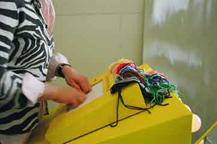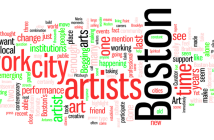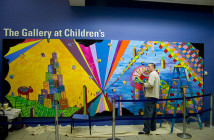No more than in any other occupation can the ‘worker’ define their role to themselves than in the fine arts, that is to say the “fine arts” one would practice to attain the degree of BFA or MFA. The worker can be either master painter or social scientist. Their work can be breathtaking or purely cerebral.
In the cases where they’re trying to create work to say something in way not said before, they always run the risk that no one will understand it; some take this into account, some ignore it altogether, others end up somewhere in between. The issue is the negotiation between how the artists wants to speak, and how they can make us understand what it is they’d like to say. Does their work arbitrarily illustrate a concept or is there no better way to say what’s being said? Sometimes conceptual artists are great at re-articulating what ‘is,’ surrounding it with a new rhetoric and subverting any hierarchies at the helm of our consciousnesses. Sometimes, they’re just bad, heavy-handed poets.
For an artist who has just entered the Maine College of Art’s MFA program, though they may be capable of creating beautiful or compelling work and have a knack for the organization of line, texture, object, idea, etc., they must now deconstruct it all. It is not as if they didn’t know what they were getting into, as a proposal was necessary for the admissions process, but it is June and they have just stepped into what some have nicknamed MFA boot camp: an 8-week, intensive studio and academic gauntlet of every discipline you can dream up and every dusty binding between Adorno and Wittgenstein (forgive me if I’ve left anyone out).
It is my hope that the professors of the program intend to root out the ‘bad poet’ tendencies of some conceptual artists and make them into excellent communicators. The program itself seems to essentially be an MFA in conceptual art. Its proprietors “support and encourage interdisciplinary studies. The program integrates a rigorous studio discipline with a close study of theory and cultural and visual studies giving students the ability to situate themselves and their work historically.” (p. 2) It is no surprise that Mary Kelly was a recent visiting artist at MECA.
With conceptual work, instead of situating themselves and their work historically, the artist uses their work to situate history. This work can be can entail some peril; however, as it always attempts to employ language and various signifiers in order to expose the cultural threads of those signifiers. The interpretation of the work’s re-mixed presentation of signifiers is up the viewer, however, and therein lies the disconnect: in order for the work to achieve success the viewer must understand what the artist wants to say. Barak Olins’ concept, to take bricks from the crematoria of Birkenau and build a makeshift bread oven to bake bread intended be distributed amongst onlookers, takes that risk. I say risk because it may very well take just as much creativity for a viewer to misconstrue this project as a horribly wanton act of irreverence. It should be noted, however, that Barak’s proposal to the International Auschwitz Council stressed the “respectful and careful temporary transformation of the site…”(18) Olins’ hope was to remove the wickedness associated with the bricks and allow for all who suffer from what happened there to mitigate their pain by “reclaim[ing]the rightful use of ovens and… restor[ing]the dignity to this strewn brick.” (19)
As with Olins, Dana Bell seeks to incorporate the viewer into the work, except she takes it a step further in that viewer participation is necessary for the work to function. In doing so the ‘hierarchical structure’ created between object d’art and viewer no longer applies. Each aspect of the work has a specific codified purpose, though figuring all of them out without Bell as a guide is practically impossible. In the end, however, they are not all important: the work draws the viewer in as participant with an insidious game-show aesthetic and a simple interface to create line drawings on video monitors that face out word from the ‘arena’-like construction of the piece. This system created by Bell pulls the viewer in to a hierarchical structure of her own creation, and she watches maniacally as we become participant-performers in her sinister invention.
In one case in particular the work only illustrates the ‘concept,’ providing only a visual aid to a greater endeavor, the 70-page thesis all MECA MFA candidates must complete. Nancy Schreiber Nesvet’s work is without question beautiful; she photographs and paints a similar and popular subject, the sky. Her thesis focuses on the relationship between photo and painting and the implications of each medium. However, the relationship is made mundane by the focus on a singular subject in her thesis work.
When I look at another photographer’s work, Eileen Fell, I am reminded of memories long past. She seems to have mastered the creation of images that remind us all of places we’ve been or sights we’ve seen, perhaps thousands of times, but just don’t recall them in space and time. Her work was displayed with wall labels at the butt ends of walls coming out from a central point. This disassociates the photos with the accompanying structure and milieu of a gallery (which would invariably lend an extraneous dialogue to the work) and allows them to exist as floating points on the white plain of a wall.
What MECA seems to do for their students is make them more aware of the positioning that takes place with a work and a viewer. No matter what, much of the thinking behind work in the show attempts to describe our perception of what is. It does not try to describe “reality” however, the work, or at least the thought behind the work, addresses the act of perceiving and the making of a reality out of that perception. In so doing, many of the artists do indeed discuss their work in relation to the viewer, and this relationship is what makes (or breaks) the success of any work in the visual medium, right?
Links:
Maine College of Art
"The Masters of Fine Arts Exhibition" is on view at Portland Yacht Services, 58 Fore St., Portland, ME, on behalf of the Institue of Contemporary Art at Maine College of Art.
All images are courtesy of the artists and MECA.
Christian Holland is a regular
contributor to Big, Red & Shiny.



